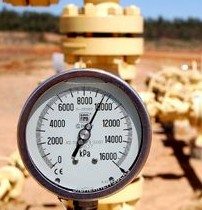The CO2-emission intensity for electrical power production fueled by natural gas is about half that of coal. Consequently, natural gas is mooted as a potential transitional or bridging fuel to a cleaner energy future. In the local context, it is suggested Australia could meet its 2020 emission reductions targets simply by replacing a significant fraction of its coal-fired electrical power with gas. Doing so could provide additional benefits. For example, in halving the volumes of CO2 emitted per unit of electrical power, it would make the challenge of commercialising Carbon Capture and Storage significantly less daunting than for coal.
However, methane is a very much more powerful greenhouse agent than CO2. So significant leakage of methane during gas production and distribution would compromise its emission intensity advantage relative to coal. At timescales of 100 years, methane has a global warming potential around 30 times greater than that of CO2 [1]. Over a 20-year period the potential is more than 100 times higher than CO2.
The caveat on the coal to gas “clean energy” argument is that natural gas fugitive emissions are not significantly higher than those associated with coal mining, on an energy equivalent basis. For conventional gas technologies, fugitive emissions are estimated at about 2.5% of total production [2]. On an energy equivalent basis, that is about the same as the fugitive emissions expected from coal mining [2,3].
On that basis we would expect a coal to gas transition will eventually lead to a significant reduction in emissions, relative to the business as usual case. But the real question is how would it impact climate?
This question has been addressed by Tom Wigley [3], and the results are sobering. Wigley’s analysis indicates that:
1) any such cooling is likely to be very modest, amounting to only a few tenths of a degree cooling relative to business as usual over timescales of 100 years or more, and
2) long-term cooling will follow a period of about 40 years where cooling is more than offset by a warming penalty incurred by concomitant reductions in sulphur-emissions.
In emphasising the paradoxical complexity of the climate system, Wigley’s findings show that any climate benefit of a coal to gas transition is neither significant in sum, nor apparent in the near-term.
More worrying still is that this analysis is only appropriate for a transition that involves conventional gas resources. Because conventional gas resources are limited, the option that gas provides as a transitional fuel is more dependent on technologies that allow economic production from unconventional resources, for which the fugitive emissions profiles are poorly understood.
Developments in technologies such as horizontal drilling and “fracking” have opened a raft of unconventional resources, allowing commercial production from coal-seam gas, tight gas and shale gas resources. In the US, the Department of Energy predicts that by 2035 total domestic production will grow by 20%, with unconventional gas providing 75% of the total [4]. The greatest growth is predicted for shale gas, predicted to grow from 16% of total production in 2009 to 45% in 2035.
As noted earlier, because the global warming potential of methane is so high compared to CO2, any advantage of natural gas over coal in meeting emissions targets would be completely offset if fugitive emissions were as little as a few percent above the baseline of conventional resources. Consequently, the fugitive emission profile of unconventional resources is crucial to any prospect that natural gas can act as a route to meeting emissions targets, let alone positive climate outcomes.
The key issue is that the fugitive emissions profile for unconventional gas technologies is extremely poorly constrained. In a recent study, Howarth et al. [5] conclude that the fugitive emission profile of shale gas could be 3 times higher than for conventional gas. On the 20-year horizon, that would mean its greenhouse gas footprint could be as much as 100% greater than coal on an energy equivalent basis.
Not surprisingly, the Howarth study has been hotly contested. Industry advocates have been keen to debunk the risk. In another study, Hultman et al. [6] argue that fugitive emissions for shale gas are very likely only about 11% higher than those of conventional gas. However, in a salutory byline Hultman and coauthors are at pains to emphasise that ”it is extremely important to note that (their) results derive from uncertain estimates of fugitive emissions from unconventional gas well development”.
Uncertainty is a key issue as Australia seeks to take advantage of its formidable unconventional gas resource.
For example, Wigley has shown that for the fugitive emission scenarios proposed by the Howarth study, a coal to gas transition will likely warm the climate at a faster rate than business for at least the next 100 years. Under such circumstances a transition to gas would be in no way beneficial to meeting any reasonable global climate objectives. Even for a 2.5% fugitive emission standard, the climate will likely warm relative to a business as usual case out to around 2050. That is because replacing coal with gas will significantly reduce sulphur-emissions which currently act to suppress climate warming on short time-scales.
It is very likely that unconventional gas extraction will result in varied emission profiles depending on the technology and the site-specific attributes of the individual production fields. It is also clear that there is currently very little understanding of the spectrum of fugitive emissions profiles for unconventional gas resources, either internationally or in Australia. Currently in Australia there is virtually no publicly available, independently verifiable fugitive emission data relevant to any specific unconventional production fields.
These issues raise fundamental concerns that need to be addressed by industry and government if the broader community is to have confidence that a coal to gas transition is to help, rather than hinder, meeting climate targets.
[1] Shindell, D.T., Faluvegi, G., Koch, D.M., and Schmidt, G.A., 2009, Improved Attribution of Climate Forcing to Emissions: Science. V 326, p.717-718, doi: 0.1126/science.1174760
[2] Hayhoe, K., Kheshgi, H.S., Jain, A.K., and Wuebbles, D.J., 2002, Substitution of Natural Gas for Coal: Climatic Effects of Utility Sector Emissions – Springer: Climatic Change, v. 54, no. ½, p. 107–139, doi: 10.1023/A:1015737505552.
[3] Wigley, T.M.L., 2011, Coal to gas: the influence of methane leakage: Climatic Change, v. 108, no. 3, p. 601–608, doi: 10.1007/s10584-011-0217-3.
[4] EIA (2010) Annual energy outlook 2011 early release overview. DOE/EIA-0383ER(2011). Energy Information Agency, U.S. Department of Energy. http://www.eia.gov/forecasts/aeo/pdf/ 0383er(2011).
[5] Howarth, R.W., Santoro, R., and Ingraffea, A., 2011, Methane and the greenhouse-gas footprint of natural gas from shale formations: Climatic Change, v. 106, no. 4, p. 679–690, doi: 10.1007/s10584-011-0061-5.
[6] Hultman, N., Rebois, D., Scholten, M., and Ramig, C., 2011, The greenhouse impact of unconventional gas for electricity generation: Environmental Research Letters, v. 6, no. 4, p. 044008, doi: 10.1088/1748-9326/6/4/044008. See also, Cathles, L.M., Brown, L., Taam, M., and Hunter, A., 2012, A commentary on “The greenhouse-gas footprint of natural gas in shale formations” by R.W. Howarth, R. Santoro, and Anthony Ingraffea: Climatic Change, v. 113, no. 2, p. 525–535, doi: 10.1007/s10584-011-0333-0. and for a response, Howarth, R.W., Santoro, R., and Ingraffea, A., 2012, Venting and leaking of methane from shale gas development: response to Cathles et al.: Climatic Change, v. 113, no. 2, p. 537–549, doi: 10.1007/s10584-012-0401-0.
Mike Sandiford is Director, Melbourne Energy Institute at University of Melbourne
This article was originally published on The Conversation – theconversation.edu.au. Reproduced with permission.










